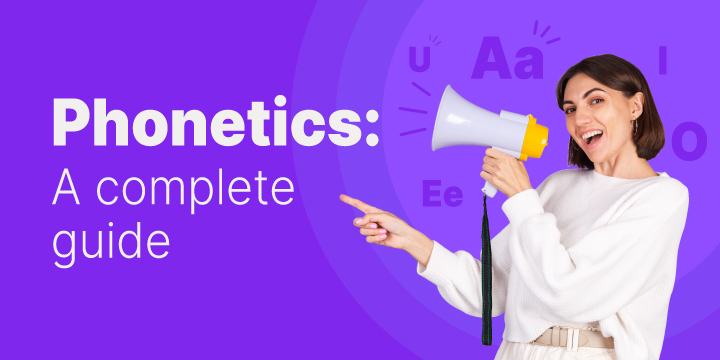The word phonetics may sound familiar to you. Phonetics is a branch of linguistics. Anyone who has studied a paper related to linguistics or taken interest in the subject is familiar with this branch. But very few of them have an idea about the usage of this branch of linguistics in language teaching.
With the arrival of English Language Teaching as a part of Applied Linguistics along with the other branches of linguistics, phonetics has been shown to have real potential in helping language teachers and trainers. Learning how to teach phonetic symbols is a crucial part of getting comfortable with the English language.
Now before we go in deep, we should discuss what Phonetics is and what are the aspects of language that are dealt with by this branch.

Definition of Phonetics:
Phonetics is the study of the sounds made by the human voice in speech.
Identification of those human speech sounds and integration of those sounds with the syllables of the different words to be taught can be the key to ease of remembering vocabulary and their pronunciation. Phonetics basically deals with phonemes. A word is made of one or more than one syllable and a syllable is made of phonemes.
Definition of Phonemes

A phenome is the smallest unit of sound in a word that makes a difference in its pronunciation, as well as its meaning, from another word. For instance, the /s/ in ‘soar’ distinguishes it from /r/ in ‘roar’, as it becomes different from ‘soar’ in pronunciation as well as meaning.
IPA or International Phonetic Alphabet is a very important tool when you’re learning how to teach phonetic symbols. Now The IPA was first published in 1888 by the Association Phonétique Internationale (International Phonetic Association).
If the above symbols are presented in front of the language students by the teachers the students will not be able to cope with the pronunciation of each symbol.
In the beginning, the teacher should try to customize a personal set of words to teach them the right pronunciation of words, syllables, and phonemes. But before that, we will have to know what are the things that make IPA useful. This will help us create a good instructional aid for the students.
- The IPA is used in dictionaries to indicate the pronunciation of words.
- The IPA has often been used as a basis for creating new writing systems for previously unwritten languages.
- The IPA is used in some foreign language textbooks and phrasebooks to transcribe the sounds of languages that are written with non-Latin alphabets. It is also used by non-native speakers of English when learning to speak English.
To make the students aware of the speech sounds it will be wise to teach the difference between vowel and consonant sounds.
Vowel Sounds
A vowel sound is a speech sound produced by humans when the breath flows out through the mouth without being blocked by the teeth, tongue, or lips:
A short vowel is a short sound as in the word “cup”.
A long vowel is a long sound as in the word “shoe”.
The vowels in English are a, e, i, o, and u.
Consonant Sounds
A consonant sound is one of the speech sounds or letters of the alphabet that is not a vowel. Consonants are pronounced by stopping the air from flowing easily through the mouth, especially by closing the lips or touching the teeth with the tongue. In other words, a consonant sound is a speech sound produced by human beings when the breath that flows out through the mouth is blocked by the teeth, tongue, or lips. Except for the vowels in English – a, e, i, o, u, and sometimes y – all the letters are consonants.
Learning to Pronounce: Vowels

- a – baby, cake, rain, day
- e – me, eve, hear, meet, piece
- i – silent, bike, light
- o – go, home, toe, boat, snow
- u – music, mule
From the above words, one can identify different pronunciations of the same letter used in different words. While teaching these words it will be very effective in the case of children if the teachers use photos of the objects signified by the words.
Now let us look at the different types of pronunciations of the same vowel letter in different words according to their usage and position in a word.
A
- a – baby
- a_e – cake
- ai – rain
- ay – play
- ei – reindeer
- eigh – weight
- ea – steak
- ey – they
E
- e – be
- e_e – eve
- ee – meet
- ea – beach
- ei – protein
- ie – piece
- ey – key
- y – candy
I
- i – silent
- i_e – shine
- ie – pie
- igh – light
- y – my
- y_e – type
O
- o – go
- o_e – phone
- oe – toe
- oa – boat
- ow – snow
U
- u – music
- u_e – mule
- ue – rescue
- eu – feud
- ew – few
- oo – food
- ou – soup
Learning to Pronounce: Consonants

| Letters | Sounds | Examples |
| b | [b] | baby, best, buy, bring, blind, absent, about, number, labor, robber, tub |
| c | [s][k] | center, cellar, cigarette, cinema, agency, notice; cake, come, cucumber, clean, cry, scratch, act, panic |
| d | [d] | day, dear, die, door, duty, admire, hidden, lady, kind, ride, ended |
| f | [f] | fast, female, five, forest, fund, fry, flight, often, deaf, cuff |
| g | [g][j][zh] | game, gap, get, go, gun, great, global, giggle, ago, begin, dog, egg; general, gin, giant, agent, suggest, Egypt, energy, huge, manage; mirage, garage, beige, rouge |
| h | [h][-] | hair, help, history, home, hotel, hunt, behind, inherit; hour, honor, honest, heir, vehicle, Sarah |
| j | [j] | jam, Jane, jet, jelly, Jim, jingle, joke, John, June, just |
| k | [k] | Kate, kind, kill, kilogram, sky, blanket, break, take, look |
| l | [l] | late, let, live, alone, close, slim, please, old, nicely, table, file, all |
| m | [m] | make, men, mind, mother, must, my, common, summer, name, form, team |
| n | [n] | napkin, never, night, no, nuclear, funny, student, kindness, ton, sun |
| p | [p] | paper, person, pick, pour, public, repair, apple, keep, top, crisp |
| q (qu) | [kw][k] | quality, question, quiet, quote, equal, require; unique, technique, antique, grotesque |
| r | [r] | rain, red, rise, brief, grow, scream, truck, arrive, hurry, turn, more, car |
| s | [s][z] | send, simple, song, system, street, lost, kiss, release; cause, present, reason, realism, advise, always, is, was |
| t | [t] | tsk, tell, time, tone, tune, hotel, attentive, student, boat, rest |
| v | [v] | vast, vein, vivid, voice, even, review, invest, give, move, active |
| w | [w] | wall, war, way, west, wind, word, would swear, swim, twenty, twist |
| x | [ks][gz][z] | exercise, exchange, expect, ex-wife, axis, fix, relax;exam, exact, executive, exert, exist, exit, exult;Xenon, Xerox, xenophobia, xylophone |
| z | [z][ts] | zero, zoo, horizon, puzzle, crazy, organize, quiz, jazz; pizza, Mozart, Nazi, waltz |
In the case of consonants as well as vowels, if the students are taught with the examples to teach them the write speech sound to be pronounced for the specific syllable, they will be able to pronounce a word correctly by looking at the spelling of the word and in some cases taking help from the dictionaries. Learning how to teach phonetic symbols then, can create an all-round English education feature.
By going through the above article you can understand that to teach Phonetics to laymen one will have to use diagrams and will have to involve the class in regular discussions. Wise App can be very useful in making this work easy for teachers.
Wise App is a one-stop solution for online teaching. Wise allows teachers to schedule and conduct live classes with a single click of a button. Additionally, teachers can collect fees, send assignments, conduct tests, facilitate discussions and share study material. Wise is easy to use and get started with. It only takes minutes to sign up and create your first class. You and your students can sign in from anywhere and from any device: Windows, Mac, iOS, and Android.
Growing the Business of teaching English

For growing the business of teaching English, the person, communicating with the new students being approached, will have to be a little bit helpful and friendly from the beginning. More the students feel comfortable more chances are there of buying the courses.
The teacher from the very start will have to understand one thing. They should not point out the weakness of any student in a manner that will raise anxiety. The level of anxiety being increased will cause can affect the performance and create the possibility of thinking of giving up. So, the teacher should in all cases have to be patient and will have to motivate all types of students so that they feel to stay within the process. But the teacher should always provide them the opportunities to work on their weaknesses.
Besides that, the teacher to increase business should distribute some free materials for the people who can be interested in the future. This can be some handout prepared by her/him or can be a prerecorded video lecture shared through social media. The advertisement should also contain some clips from the video lectures the teacher will be providing the paid students.




